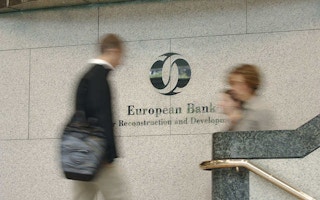The European Bank for Reconstruction and Development will scrap most assistance for coal-fired power plants, joining the World Bank and the U.S. in a retreat from supporting the most polluting fossil fuel.
The lender’s board voted today on a new investment strategy that includes the policy on coal financing, the London-based EBRD said. Funding of power plants that burn the fuel will now go ahead only in “rare and exceptional circumstances,” said Head of Energy and Natural Resources Riccardo Puliti.
“We cannot use carbon without having a thought about what the impact of climate change is going to be,” Puliti said in an interview in London. “There is a climate-change problem, and there are actions to be undertaken in order to solve it.”
The movement to end financing for coal plants is snowballing as national governments and international development banks intensify efforts to fight climate change by targeting a fuel that produces about double the amount of carbon dioxide than natural gas. The World Bank andEuropean Investment Bank already have announced plans to shun most coal investments. Last month, Britain joined a U.S. initiative to do so.
CEE Bankwatch Network, a Prague-based non-governmental organization that monitors international finance institutions, welcomed the EBRD’s move away from coal.
‘Tiptoeing around coal’
“The strategy approved today makes it clear that everyone in the bank and in many of its shareholders’ capitals is now tiptoeing around coal,” Fidanka Bacheva-McGrath, a coordinator at the network, said in an e-mailed statement. “This should serve as one more warning for the coal industry that it can no longer ignore our health and our climate.”
The EBRD operates in 34 countries across eastern Europe and central Asia. It has invested 52 billion euros ($71 billion) in sustainable industry, infrastructure and energy since 2006, including 6.3 billion euros in power and utilities.
The bank has invested 12 billion euros in renewable power and energy efficiency since 2006, the region’s biggest investor in those technologies. It has helped develop clean-energy regulations in countries including Russia, Ukraine and Kazakhstan and funded projects from Poland toMongolia. It’s working in Turkey and aims to help countries such as Jordan and Egypt to take advantage of their solar resources.
Energy efficiency
The coal decision is part of a wider document outlining the EBRD’s investment strategy. Puliti said that energy efficiency is the “main axis” linking the policy together, including replacing fossil fuels with renewables, reducing emissions from thermal generation plants, insulating buildings and making trains and trucks less fuel-intensive.
The movement by development banks to end coal funding also reduces access to private financing for the fuel and gives the banks more money and time to spend on renewables projects, said Jake Schmidt, the Washington-based director of climate policy at the Natural Resources Defense Council.
“If these development banks show that they aren’t interested, then those projects have a much harder hurdle with the private capital market,” Schmidt said in an e-mail reply to questions before the EBRD announcement. “If they don’t fund coal projects, and these projects don’t get funding elsewhere, then the carbon pollution from these projects won’t occur.”
Multilateral developments banks such as the EBRD provided about $27 billion in financing for climate-change initiatives last year, according to a report published by seven development banks last month. Of that, support for clean energy amounted to more than 7.5 billion euros.
UN target
United Nations scientists said in September that humans have already emitted more than half of the carbon that’s compatible with limiting global warming to 2 degrees Celsius (3.6 degrees Fahrenheit) since the industrial revolution. Beyond that level, which has been endorsed by world leaders, the impact of climate change becomes more destructive.
The EBRD’s funding for coal only represents a fraction of its investments. Since 2006, the bank made 521 million euros of investment in coal generation out of the 6.3 billion spent on power and utilities. Puliti said that proportion will be even lower in the future.
‘Rare’ exceptions
“We really mean it when we say, ‘rare and exceptional,’” he said. “It will be less than that going forward for the very simple reason that the new strategy is more restrictive.”
Puliti said that none of his bankers are currently working on coal, and the only country where the bank operates that he envisages may need coal funding is Mongolia.
“Mongolia is not connected to any gas pipeline, it’s not connected to any oil pipeline and they don’t take nuclear.” said Puliti. “The first wind farm in Mongolia has been developed and financed by the EBRD. But the problem in Mongolia is not only a problem of producing electricity, it’s producing heat. And you cannot produce heat with renewables.”
Any coal plant getting financing would need to prove that no other fuel would be viable, said Puliti. It should be built with the “best available technique” to minimize emissions, and be ready to take carbon capture and storage equipment if commercially viable technology is developed, he said.










